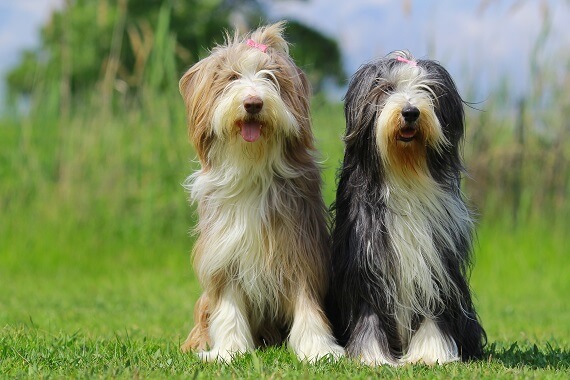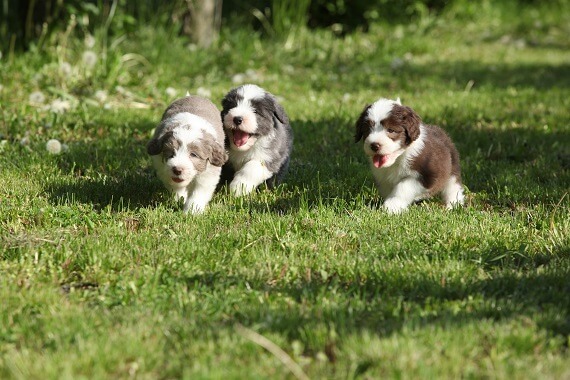
The bearded collie is one of the oldest dog breeds found in the UK and was bred for herding sheep and cattle. ‘Collie’ is a Scottish word for dogs that herd sheep. It is native to the Scottish highlands, where it has been used for centuries as a working dog. It is likely that these dogs’ ancestors were Polish lowland sheepdogs left in Scotland in the 1500s, which bred with native herding dogs from the UK. The breed was recognized in 1840. Bearded collies are a medium-sized dog that has a slender frame. It has a shaggy coat and long hair that covers its ears, legs, tail, and muzzle. It has a double coat, which consists of a long outer layer which is harsh in texture and a short, dense undercoat. They can be black, blue, brown, or fawn and often have large white patches or markings on their chest, feet, and tail. Bearded collies are highly intelligent, energetic, and strong. They have high endurance and are very hardy. Also, these dogs are swift and agile, which makes them fantastic working dogs. They have an outgoing and affectionate temperament. These dogs interact well with other animals, especially if they are introduced from an early age. Bearded collies need a good amount of exercise and attention. They get bored quickly and can exhibit destructive behaviors if left alone for long periods of time. The bearded collie was first introduced to the US in the late 1950s, and in 1969 the Bearded Collie Club of America was founded. The breed became popular as a show dog, and from 1977 it became eligible to be shown in the American Kennel Club’s (AKC) Miscellaneous Class. It was given full status as part of the AKC’s Herding Group in 1983. Bearded collies are one breed of herding dog that has been put to work on farms by people for centuries. People use selective breeding with dogs to breed animals that display specific desirable characteristics. Dogs have several wonderful biological adaptations that make them suited for certain environments. Let’s take a closer look. Bearded collies are herding dogs that are used by farmers to move cattle and sheep. This type of behavior has come about through selective breeding. Dogs naturally are predators, and by modifying this behavior, humans have been able to breed working dogs that are useful for herding other animals. Through selective breeding, people have been able to minimize the dog’s natural instinct to treat cattle and sheep as prey while also keeping the dog’s hunting skills. Bearded collies direct animals by staring at them until they move, using something that is known as ‘strong eye.’ These dogs will consistently go to the head of the animal and redirect its movement. This is different from other breeds of herding dogs, such as the Australian cattle dog, which will frequently nip at the heels of the animals to get them to move. Bearded collies were bred to be working animals and have a strong, lean body with straight front legs and muscled hindquarters. Their physical appearance is very athletic, which enables them to cover long distances and work long hours. These characteristics made this dog a favorite of shepherds in Scotland, where the landscape can be very hilly and rugged, and the weather can often be cold and harsh. These dogs were expected to help control cattle and sheep at pasture and drive the herd to market. A dog’s eyesight is dichromate, which means they have color vision equivalent to red-green color blindness in humans. This is because a dog’s retina has more rod cells that see in shades of grey, while human retinas are primarily composed of cone cells that perceive color. Rods need much less light to function than cones do, which means that dogs have a much better night vision than we do. It doesn’t mean that dogs can’t see red, it’s just not as vibrant to them and appears to be browner in color. Dogs’ eyes also have an additional layer, called a tapetum, which is found at the back of the retina. This layer is reflective, and so any light that is not absorbed by photoreceptors can bounce back and forth, which gives it another chance at being recognized. This is the reason that dogs have such good night vision. While a dog’s vision is not overly sharp, they do have very high visual discrimination. Dogs can distinguish between two different humans from distances up to a mile!
Kingdom
Animalia
Phylum
Chordata
Class
Mammalia
Order
Carnivora
Family
Canidae
Genus
Canis
Species
Canis lupus
Subspecies
Canis lupus familiaris
Height
20–22 in ( 51–56 cm) at the shoulder
Weight
40–60 lb (18–27 kg)
Lifespan
12 – 14 years
Social Structure
Domesticated
Status
Least concern
Natural Habitat
Domesticated, prefer herding activities
Average Litter Size
4 – 12
Main food item
Dog food
Potential predators
Few predators
The Basics

Fun Facts about the Bearded Collie
Herding Behaviour

Adapted for Work

Dogs Are Color Blind
